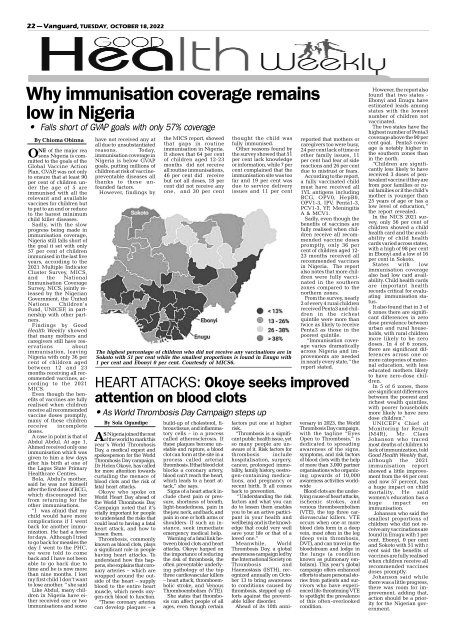Create successful ePaper yourself
Turn your PDF publications into a flip-book with our unique Google optimized e-Paper software.
22 — Vanguard, TUESDAY, OCTOBER 18, 2022<br />
‘<br />
Why immunisation coverage remains<br />
low in Nigeria<br />
• Falls short of GVAP goals with only 57% coverage<br />
By Chioma Obinna<br />
ONE of the major rea<br />
sons Nigeria is committed<br />
to the goals of the<br />
Global Vaccine Action<br />
Plan, GVAP, was not only<br />
to ensure that at least 90<br />
per cent of children under<br />
the age of 5 are<br />
immunised with all the<br />
relevant and available<br />
vaccines for children but<br />
to put to an end or reduce<br />
to the barest minimum<br />
child killer diseases.<br />
Sadly, with the slow<br />
progress being made in<br />
immunisation coverage,<br />
Nigeria still falls short of<br />
the goal it set with only<br />
57 per cent of children<br />
immunised in the last five<br />
years, according to the<br />
2021 Multiple Indicator<br />
Cluster Survey, MICS,<br />
and the National<br />
Immunisation Coverage<br />
Survey, NICS, jointly released<br />
by the Nigerian<br />
Government, the United<br />
Nations Children’s<br />
Fund, UNICEF, in partnership<br />
with other partners.<br />
Findings by Good<br />
Health Weekly showed<br />
that many mothers and<br />
caregivers still have reservations<br />
about<br />
immunisation, leaving<br />
Nigeria with only 36 per<br />
cent of children aged<br />
between 12 and 23<br />
months receiving all recommended<br />
vaccines, according<br />
to the 2021<br />
MICS.<br />
Even though the benefits<br />
of vaccines are fully<br />
realised when children<br />
receive all recommended<br />
vaccine doses promptly,<br />
many of these children<br />
receive incomplete<br />
doses.<br />
A case in point is that of<br />
Abdul Abdul. At age 1,<br />
Ahmed received only one<br />
immunisation which was<br />
given to him a few days<br />
after his birth at one of<br />
the Lagos State Primary<br />
Healthcare Centres.<br />
Bola, Abdul's mother,<br />
said he was not himself<br />
after the first dose of BCG,<br />
which discouraged her<br />
from returning for the<br />
other immunisations.<br />
“I was afraid that my<br />
child would have more<br />
complications if I went<br />
back for another immunization.<br />
He had a fever<br />
for days. Although I tried<br />
to go back for measles the<br />
day I went to the PHC,<br />
we were told to come<br />
back and I have not been<br />
able to go back due to<br />
time and he is now more<br />
than nine months. I lost<br />
my first child I don’t want<br />
to lose another. ” she said<br />
Like Abdul, many children<br />
in Nigeria have either<br />
received one or two<br />
immunisations and some<br />
have not received any at<br />
all due to unsubstantiated<br />
reasons. Today,<br />
immunisation coverage in<br />
Nigeria is below GVAP<br />
goals, putting millions of<br />
children at risk of vaccinepreventable<br />
diseases all<br />
thanks to these unfounded<br />
factors.<br />
However, findings by<br />
The highest percentage of children who did not receive any vaccinations are in<br />
Sokoto with 51 per cent while the smallest proportions is found in Enugu with<br />
1 per cent and Ebonyi 0 per cent. Courtesdy of MICS6.<br />
HEART ATTACKS: Okoye seeks improved<br />
attention on blood clots<br />
• As World Thrombosis Day Campaign steps up<br />
By Sola Ogundipe<br />
AS Nigeria joined the rest<br />
of the world to mark this<br />
year’s World Thrombosis<br />
Day, a medical expert and<br />
spokesperson for the World<br />
Thrombosis Day campaign,<br />
Dr Helen Okoye, has called<br />
for more attention towards<br />
curtailing the menace of<br />
blood clots and the risk of<br />
fatal heart attacks.<br />
Okoye who spoke on<br />
World Heart Day ahead of<br />
the World Thrombosis Day<br />
Campaign noted that it’s<br />
vitally important for people<br />
to understand the risks that<br />
could lead to having a fatal<br />
heart attack, and how to<br />
lessen them.<br />
Thrombosis, commonly<br />
known as blood clots, plays<br />
a significant role in people<br />
having heart attacks. To<br />
understand how this happens,<br />
she explains that coronary<br />
arteries – which are<br />
wrapped around the outside<br />
of the heart – supply<br />
blood to the entire heart<br />
muscle, which needs oxygen-rich<br />
blood to function.<br />
“These coronary arteries<br />
can develop plaques – a<br />
the MICS report, showed<br />
that gaps in routine<br />
immunisation in Nigeria.<br />
It shows that 64 per cent<br />
of children aged 12-23<br />
months did not receive<br />
all routine immunisations,<br />
46 per cent did receive<br />
but not all doses, 18 per<br />
cent did not receive any<br />
one, and 30 per cent<br />
build-up of cholesterol, fibrous<br />
tissue, and inflammatory<br />
cells – in a process<br />
called atherosclerosis. If<br />
these plaques become unstable<br />
and rupture, a blood<br />
clot can form at the site in a<br />
process called arterial<br />
thrombosis. If that blood clot<br />
blocks a coronary artery,<br />
blood can’t reach the heart,<br />
which leads to a heart attack,”<br />
she says.<br />
Signs of a heart attack include<br />
chest pain or pressure,<br />
shortness of breath,<br />
light-headedness, pain in<br />
the jaw, neck, and back, and<br />
pain in one or both arms or<br />
shoulders. If such an instance,<br />
seek immediate<br />
emergency medical help.<br />
Warning of a fatal link between<br />
blood clots and heart<br />
attacks, Okoye harped on<br />
the importance of reducing<br />
the risk of thrombosis, the<br />
often preventable underlying<br />
pathology of the top<br />
three cardiovascular killers<br />
– heart attack, thromboembolic<br />
stroke, and Venous<br />
Thromboembolism (VTE).<br />
She states that thrombosis<br />
can affect people of all<br />
ages, even though certain<br />
thought the child was<br />
fully immunised.<br />
Other reasons found by<br />
the survey showed that 51<br />
per cent lack knowledge<br />
or information, while 7 per<br />
cent complained that the<br />
immunisation site was too<br />
far and 19 per cent was<br />
due to service delivery<br />
issues and 11 per cent<br />
reported that mothers or<br />
caregivers too were busy,<br />
24 per cent lack of time or<br />
other family issues, 11<br />
per cent had fear of side<br />
reactions and 26 per cent<br />
due to mistrust or fears.<br />
According to the report,<br />
a fully vaccinated child<br />
must have received all<br />
1YL antigens including<br />
BCG, OPV0, HepB0,<br />
OPV1-3, IPV, Penta1-3,<br />
PCV1-3, YF, Meningitis<br />
A & MCV1.<br />
Sadly, even though the<br />
benefits of vaccines are<br />
fully realised when children<br />
receive all recommended<br />
vaccine doses<br />
promptly, only 36 per<br />
cent of children aged 12-<br />
23 months received all<br />
recommended vaccines<br />
in Nigeria. The report<br />
also notes that more children<br />
were fully vaccinated<br />
in the southern<br />
zones compared to the<br />
northern zones.<br />
From the survey, nearly<br />
2 of every 4 rural children<br />
received Penta3 and children<br />
in the richest<br />
quintile were more than<br />
twice as likely to receive<br />
Penta3 as those in the<br />
poorest quintile.<br />
“Immunisation coverage<br />
varies dramatically<br />
across Nigeria and improvements<br />
are needed<br />
in nearly every state,” the<br />
report stated.<br />
factors put one at higher<br />
risk.<br />
“Thrombosis is a significant<br />
public health issue, yet<br />
so many people are unaware<br />
of it. Risk factors for<br />
thrombosis include<br />
hospitalisation, surgery,<br />
cancer, prolonged immobility,<br />
family history, oestrogen-containing<br />
medications,<br />
and pregnancy or<br />
recent birth. It all comes<br />
back to prevention.<br />
“Understanding the risk<br />
factors and what you can<br />
do to lessen them enables<br />
you to be an active participant<br />
in your health and<br />
wellbeing and is the knowledge<br />
that could very well<br />
save your life or that of a<br />
loved one.”<br />
Meanwhile, World<br />
Thrombosis Day, a global<br />
awareness campaign led by<br />
the International Society on<br />
Thrombosis and<br />
Haemostasis (ISTH), recognized<br />
annually on October<br />
13 to bring awareness<br />
to conditions caused by<br />
thrombosis, stepped up efforts<br />
against the preventable<br />
killer disorder.<br />
Ahead of its 10th anniversary<br />
in 2023, the World<br />
Thrombosis Day campaign,<br />
with the tagline “Eyes<br />
Open to Thrombosis,” is<br />
dedicated to spreading<br />
awareness of the signs,<br />
symptoms, and risk factors<br />
of blood clots with the help<br />
of more than 3,000 partner<br />
organisations who organizing<br />
upwards of 10,000<br />
awareness activities worldwide<br />
Blood clots are the underlying<br />
cause of heart attacks,<br />
ischemic strokes, and<br />
venous thromboembolism<br />
(VTE), the top three cardiovascular<br />
killers. VTE<br />
occurs when one or more<br />
blood clots form in a deep<br />
vein, most often in the leg<br />
(deep vein thrombosis,<br />
DVT), and can travel in the<br />
bloodstream and lodge in<br />
the lungs (a condition<br />
known as pulmonary embolism).<br />
This year’s global<br />
campaign offers enhanced<br />
efforts to share personal stories<br />
from patients and survivors<br />
who have experienced<br />
life-threatening VTE<br />
to spotlight the prevalence<br />
of this often-overlooked<br />
condition.<br />
However, the report also<br />
found that two states -<br />
Ebonyi and Enugu have<br />
estimated leads among<br />
states with the lowest<br />
number of children not<br />
vaccinated.<br />
The two states have the<br />
highest number of Penta3<br />
coverage above the 90 per<br />
cent goal. Penta3 coverage<br />
is notably higher in<br />
the southern zones than<br />
in the north.<br />
“Children are significantly<br />
less likely to have<br />
received 3 doses of pentavalent<br />
vaccine if they are<br />
from poor families or rural<br />
families or if the child’s<br />
mother is younger than<br />
25 years of age or has a<br />
low level of education,”<br />
the report revealed.<br />
In the NICS 2021 survey,<br />
only 56 per cent of<br />
children showed a child<br />
health card and the availability<br />
of child health<br />
cards varied across states,<br />
with a high of 98 per cent<br />
in Ebonyi and a low of 16<br />
per cent in Sokoto.<br />
States with low<br />
immunisation coverage<br />
also had low card availability.<br />
Child health cards<br />
are important health<br />
records critical for evaluating<br />
immunisation status.<br />
It also found that in 3 of<br />
6 zones there are significant<br />
differences in zero<br />
dose prevalence between<br />
urban and rural households,<br />
with rural children<br />
more likely to be zero<br />
doses. In 4 of 6 zones,<br />
there are significant differences<br />
across one or<br />
more categories of maternal<br />
education, with less<br />
educated mothers likely<br />
to have zero-dose children.<br />
In 5 of 6 zones, there<br />
are significant differences<br />
between the poorest and<br />
richest wealth quintiles,<br />
with poorer households<br />
more likely to have zero<br />
dose children.”<br />
UNICEF’s Chief of<br />
Monitoring for Result<br />
(M4R), Mr Claes<br />
Johanson who traced<br />
most deaths of children to<br />
lack of immunization, told<br />
Good Health Weekly that,<br />
although the 2021<br />
immunisation report<br />
showed a little improvement<br />
from the 44 per cent<br />
and now 57 percent, has<br />
a huge impact on child<br />
mortality. He said<br />
women’s education has a<br />
huge impact on<br />
immunisation.<br />
Johanson who said the<br />
smallest proportions of<br />
children who did not receive<br />
any vaccinations are<br />
found in Enugu with 1 per<br />
cent, Ebonyi, 0 per cent<br />
and Sokoto with 51 with r<br />
cent said the benefits of<br />
vaccines are fully realised<br />
when children receive all<br />
recommended vaccines<br />
doses promptly.<br />
Johanson said while<br />
there was a little progress,<br />
there was room for improvement,<br />
adding that,<br />
action should be a priority<br />
for the Nigerian government.


















